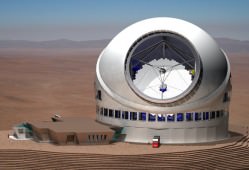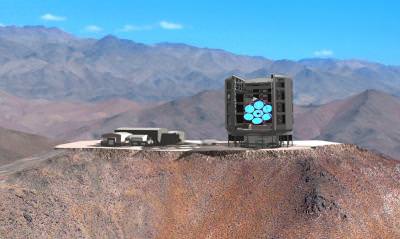[/caption]
Astronomy organizations in the United States, Australia and Korea have signed on to build the largest ground-based telescope in the world – unless another team gets there first. The Giant Magellan Telescope, or GMT, will have the resolving power of a single 24.5-meter (80-foot) primary mirror, which will make it three times more powerful than any of the Earth’s existing ground-based optical telescopes. Its domestic partners include the Carnegie Institution for Science, Harvard University, the Smithsonian Institution, Texas A & M University, the University of Arizona, and the University of Texas at Austin. Although the telescope has been in the works since 2003, the formal collaboration was announced Friday.
Charles Alcock, director of the Harvard-Smithsonian Center for Astrophysics, said the Giant Magellan Telescope is being designed to build on the legacy of a rash of smaller telescopes from the 1990s in California, Hawaii and Arizona. The existing telescopes have mirrors in the range of six to 10 meters (18 to 32 feet), and – while they’re making great headway in the nearby universe – they’re only able to make out the largest planets around other stars and the most luminous distant galaxies.
With a much larger primary mirror, the GMT will be able to detect much smaller and fainter objects in the sky, opening a window to the most distant, and therefore the oldest, stars and galaxies. Formed within the first billion years of the Big Bang, such objects reveal tantalizing insight into the universe’s infancy.
Earlier this year, a different consortium including the California Institute of Technology and the University of California, with Canadian and Japanese institutions, unveiled its own next-generation concept: the Thirty Meter Telescope. Whereas the GMT’s 24.5-meter primary mirror will come from a collection of eight smaller mirrors, the TMT will combine 492 segments to achieve the power of a single 30-meter (98-foot) mirror design.
In addition, the European Extremely Large Telescope is in the concept stage.
In terms of science, Alcock acknowledged that the two telescopes with US participation are headed toward redundancy. The main differences, he said, are in the engineering arena.
“They’ll probably both work,” he said. But Alcock thinks the GMT is most exciting from a technological point of view. Each of the GMT’s seven 8.4-meter primary segments will weigh 20 tons, and the telescope enclosure has a height of about 200 feet. The GMT partners aim to complete their detailed design within two years.
The TMT’s segmented concept builds on technology pioneered at the W.M. Keck Observatory in Hawaii, a past project of the Cal-Tech and University of California partnership.
Construction on the GMT is expected to begin in 2012 and completed in 2019, at Las Campanas Observatory in the Andes Mountains of Chile. The total cost is projected to be $700 million, with $130 million raised so far.

Construction on the TMT could begin as early as 2011 with an estimated completion date of 2018. The telescope could go to Hawaii or Chile, and final site selection will be announced this summer. The total cost is estimated to be as high as $1 billion, with $300 million raised at last count.
Alcock said the next generation of telescopes is crucial for forward progress in 21st Century astronomy.
“The goal is to start discovering and characterizing planets that might harbor life,” he said. “It’s very clear that we’re going to need the next generation of telescopes to do that.”
And far from being a competition, the real race is to contribute to science, said Charles Blue, a TMT spokesman.
“All next generation observatories would really like to be up and running as soon as possible to meet the scientific demand,” he said.
In the shorter term, long distance space studies will get help from the James Webb Space Telescope, designed to replace the Hubble Space Telescope when it launches in 2013. And the Atacama Large Millimeter Array (ALMA), a large interferometer being completed in Chile, could join the fore by 2012.
Sources: EurekAlert and interviews with Charles Alcock, Charles Blue


Wow, talk about a ‘light bucket’, great location away from any light pollution, and rarely ever rains with the possible exception of extremely
powerful El Nino episodes-this will be nice
Anne, from the first sentence you get us all excited, looking for the story of how Australia and Korea bit in the picture – then after this you just say absolutely nothing else about it!.
I,e, “Astronomy organizations in the United States, Australia and Korea have signed on to build the largest ground-based telescope in the world ”
What a put-down.
Perhaps these other two other countries here will be only be minor partners?
In fact the two Australian part of consortium are the Australian National University and Astronomy Australia Limited – both exceedingly.active in astronomy for years and years of experience – and are not technically challenged. For Korea, it is the Korean Astronomy and Space Science group. All these, including the American institutions mentioned make a total of nine members for the deal. While these ‘foreign” groups might be inconsequential in terms of population and financial contributions, the technical expertise they delivery can never underestimated. As chair of the entire GMT group, Wendy Freeman, said in April last year;
“The addition of the Australian National University to the GMT consortium is the most recent indication of the momentum that the project is generating, We all share a common goal of probing the most important questions in astronomy facing us over the next generation.”
Were it not for many foreign institutes coming on board, this project would never get of the ground. Australia’s stake in the consortium is about 15% – $110 million bucks of the Aussie taxpayer!.
Remember this is the I.A.U. INTERNATIONAL Year of Astronomy 2009. It is not the American Year of Astronomy 2009!
Also remember this future telescope will be on Chilean soil, and it would be nice once and a while to humbly acknowledge their contribution
Ta !
Salacious, very articulate! And all I was expecting was “Eee-he-he-he-he”.
I agree with you wholeheartedly!
Even if either telescope had the angular resolution to detect descent stages left on the moon, I doubt it could. The things would blend in with the lunar environment.
“the GMT will be able to detect much smaller and fainter objects in the sky, opening a window to the most distant, and therefore the oldest, stars and galaxies”
What if pointing to the surface of the moon? Could it, for example, resolve to a degree which makes the Apollo landers visible?
The first mirror is already in the works.
http://www.gmto.org/newsitems/gmt1_grind_and_polish042908
The famous Steward Observatory Mirror Lab at the University of Arizona cast the glass in July of 2005. This first mirror is one of the off-axis mirrors that was started to prove that the lab could grind it to the tolerances needed.
I have no idea how they are driving the stressed lap to grind this thing. The lab has been using these things for years but they only had to change the shape as the lap rotated and as it moved radially across the face. With this mirror, they will have to change the shape in the same modes but also with the rotation of the mirror.
An how the hell do you test a beast like this? Traditionally, the lab used laser interferometry by placing the mirror flat on the test stand and placing the test rig at the focal point. This mirror will require something completely different. Looks like I have already lost the day’s productivity while I try to figure this one out. There has to be a paper out there about this test rig. There is NO WAY they developed this without someone getting a thesis or publication out of it.
Funny to think that launching just one of those GMT mirrors into space in a NGST would create a much better telescope… But the cost would be several times higher.
Thomas, that could be. Nevertheless, there would be six opportunities out there. And the angle of incoming sunlight varies with the rotation of the moon, painting outlines of the environment and the six descent stages – each with a diameter of 4.2 meters – always differently.
Should be comparable to the resolution of two inches from New York to San Francisco.
“While these ‘foreign” groups might be inconsequential in terms of population and financial contributions, the technical expertise they delivery can never underestimated.”
Damn straight. And great to see Australia with the foresight to be investing substantially in the next generation of astronomical capability. Hopefully we get the Square Kilometre Array too…
These images lack only one thing to make them really spectacular; something to give them perspective. At first glance I thought, “Okay, a knee-high Tonka Truck with some mirrors on them!” It wasn’t until I looked closely at them and realized that off to the side were admin buildings that were *tiny* by comparison. Perhaps next time the artist could add some ant-like human figures to make us realize how really large these structures are going to be.
dollhopf…. No.
Salacious… use your CTRL+F4 keys
It never amazes me how a bigot like salacious moans and groans about lack of recognition; yet if he could manage to remove his prejudice specs he would have read more into the document, and how it does speak of contributions from many nations, as well as noticing the article does mention both possible locations for placement. Furthermore, you get a tease about ALMA in Chile.
Since we have to listen to your drabble once again, I’ll say this again…
Use CTRL+F4 if you don’t like it
I would much rather read this article, than listen to a bunch of morons spouting out, “Aussie! Aussie! Aussie! …oy OY OY!”
GMT – 24.5 meter
LBT – 22.8 meter equivalent
Is there an exponential gain with mirror size increase? Or is “3 times larger than existing earth based telescopes” pandering to donors?
Mr.Obvious,
less?
Mr.Oblivious
Thank you again for your usual predictable informed rhetorical diatribe. As usual, your general views are very much appreciated, and have brilliantly contributed towards the whole significance of this story. Enjoy your day, mate…
I love hearing news about new bigger and better telescopes that are going to reveal more info about the universe. But one thing that bothers me is when they keep adding size adjectives in their name, like the “Very Large Telescope” and then the “Extremely Large Telescope”, then what, the “Super Duper Gargantuan Telescope”? lol
Honestly, where do they think this is all going? Obviously we’re going to keep making larger and larger telescopes as we advance as a civilization and the names of these current telescopes are going to sound funny when they look back from the future on our history.
Can’t they just name them all with proper nouns, like Hubble, Keck, etc. Sounds much nicer. Makes them more personable as well.
Just my thoughts….
Not that I’m totally impressed, but this is more than I expected when I stumpled upon a link on Delicious telling that the info here is awesome. Thanks.